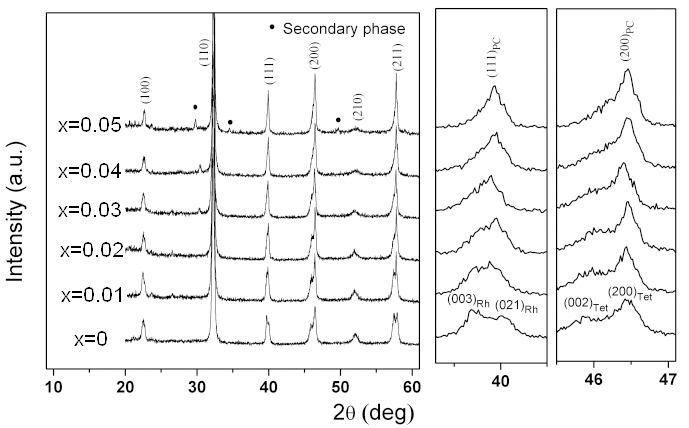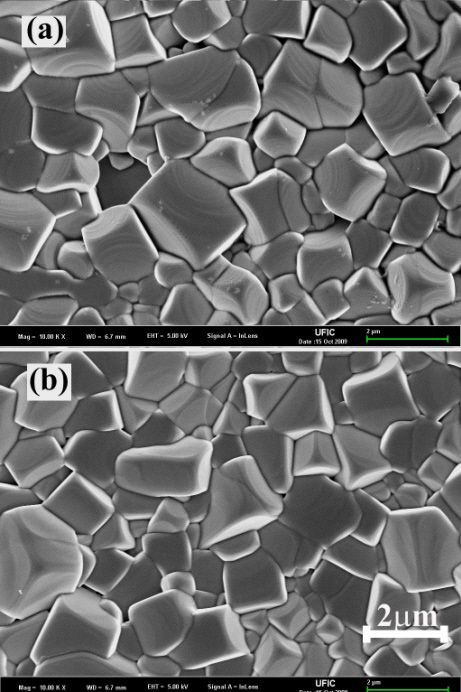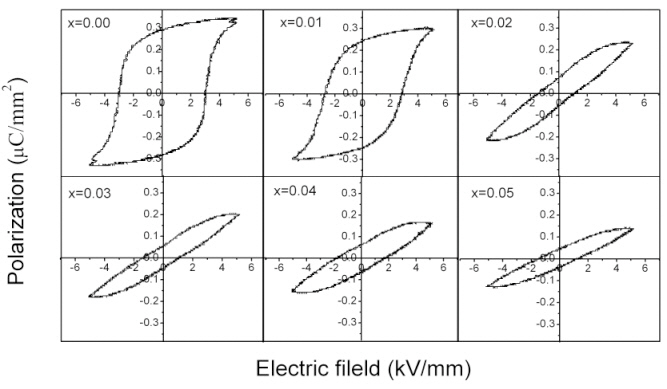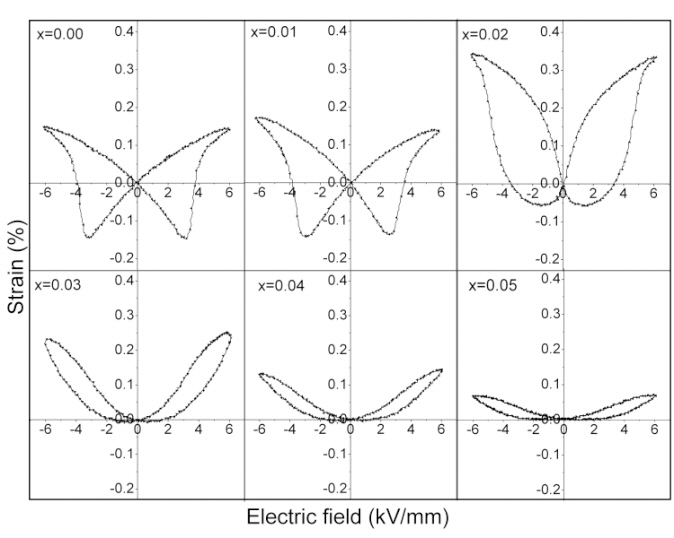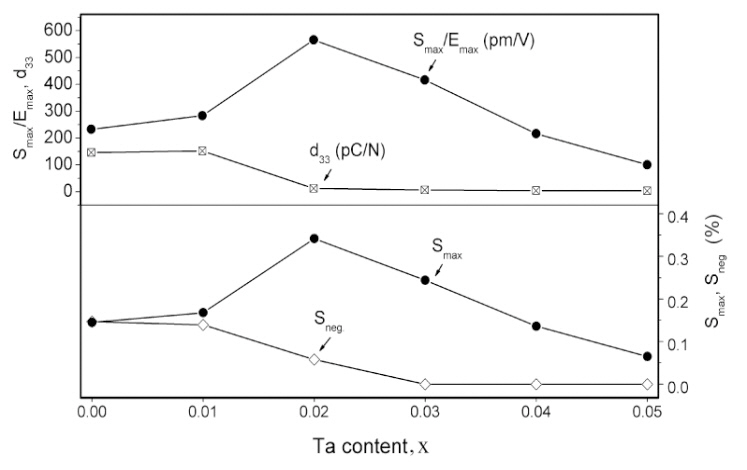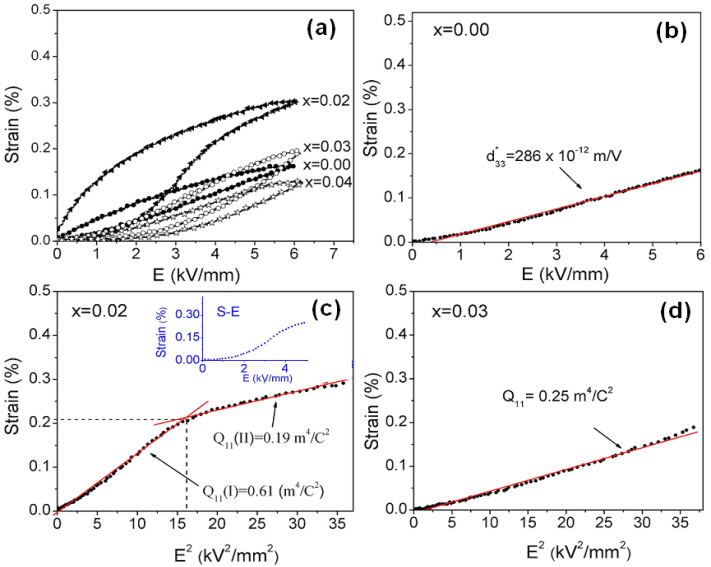The increasing demand for environmentally friendly piezoelectric materials in the electronic and automotive industries promotes a wide range of studies on new lead-free ceramics in order to replace the widely used lead zirconate titanate (PZT) based ceramics. Recently there have been extensive studies on lead-free piezoelectric ceramics as summarized in review artcles [1-4]. Among various lead-free ceramic systems, the solid solutions between bismuth sodium titanate, Bi0.5Na0.5TiO3 (BNT), and bismuth potassium titanate, Bi0.5K0.5TiO3 (BKT), are considered potential candidates to replace PZT-based ceramics.
The physical properties of these materials were first reported in 1961[5]. BNT demonstrates rhombohedral symmetry at room temperature while BKT has tetragonal symmetry. Both BNT and BKT are strongly ferroelectric (FE) and exhibit relatively high Curie points (Tc) of 320℃ and 380℃, respectively [6,7]. In a similar manner that compositions near the morphotropic phase boundary (MPB) in PZT-based ceramics have attracted great concern because of their excellent electromechanical properties [8], the substitution of tetragonal BKT by 16-20 mol. % of rhombohedral BNT provides an MPB region [9] where piezoelectric properties are much superior to those of other compositions that deviate away from the MPB [10,11].
Recently it was reported that Zr - or Hf -modified Bi0.5(Na0.78K0.22)0.5TiO3 ceramics exhibit abnormally high electricfield-induced strain (Smax/Emax > 500 pm/V) [12,13]. On the other hand, it is well known that the substitution of aliovalent dopants to A- or B-sites in ABO3-type perovskite materials can modify their FE and piezoelectric properties. Among various dopants,Ta was reported to be effective at improving field-induced strain, ferroelectricity, and the piezoelectric constant of BaTiO3-modified BNT ceramics [14]. Therefore it seems interesting to investigate the effects of Ta doping on the piezoelectric properties of BNT-BKT ceramics with a composition near the MPB. In this work, Ta5+ is substituted on Ti4+ in Bi0.5(Na0.82K0.18)0.5TiO3 (BNKT) ceramics and their crystal structure, FE, and piezoelectric properties are examined.
Bi0.5(Na82K0.18)0.5Ti1-xTaxO3 (x = 0, 0.01, 0.02, 0.03, 0.04, and 0.05), hereafter abbreviated as BNKTTa-100x, ceramics were prepared by a conventional solid-state reaction method. Powders of Bi2O3, TiO2 (99.9%, High Purity Chemicals, Saitama, JP), Na2CO3 (99.9%, Cerac Specialty Inorganics, Milwaukee, WI, USA), K2CO3 (>99%, Sigma-Aldrich, St. Louis, MO, USA), and Ta2O5 (99.9%, High Purity Chemicals) were used as raw materials. The starting powders were weighed according to the corresponding chemical formula.The powder mixture was ball-milled for 24 hours in ethanol with zirconia balls as the milling media. The slurries were dried and calcined at 850℃ for 2 hours. Polyvinyl alcohol was added as a binder to the calcined powders and the mixture was pressed into disks with a diameter of 12 mm at 100 MPa. These disks were sintered in covered alumina crucibles at 1,175℃ for 2 hours in air.
The relative density of a fired specimen was determined by the Archimedes principle. The crystal structure was analyzed using an X-ray diffractometer (XRD, RAD Ⅲ, Rigaku, Tokyo, Japan), and the surface morphology was observed with a field emission scanning electron microscope (FE-SEM, JEOL, JSM-65OFF, Tokyo, Japan). Electrical measurements were carried out after applying Ag paste on both sides of a specimen and subsequent firing at 700℃ for 30 minutes. The electric-field-induced polarization (P-E) and strain (S-E) measurements were carried out using a modified Sawyer-Tower circuit and a linear variable differential transducer, respectively. The piezoelectric constant d33 was determined using a Berlincourt d33-meter after poling samples under a dc field of 5 kV/mm for 15 minutes in silicone oil kept at 80℃. The dielectric constant and loss tangent were measured with an impedance analyzer (HP 4194A). On the basis of Institute of Electrical and Electronics Engineers (IEEE) standards [15], the planar piezoelectric coupling coefficient (kp) and electromechanical quality factor were determined using the resonanceantiresonance method.
Figure 1 represents XRD patterns of BNKTTa-100x ceramics sintered at 1175℃ for 2 hours. All compositions exhibit a typical ABO3 perovskite structure. Careful observation reveals that undoped BNKT ceramics correspond to a mixture of tetragonal and rhombohedral symmetry. Because reflections at both 40° and 46° show peak splitting, which could be attributed to the (003)/(021) planes of a rhombohedral phase [16,17] and (002)/(200) peaks of a tetragonal phase, respectively. With increasing Ta doping level (x), however, the tetragonal (002)/(200) peaks at 46° are gradually diminished and finally become a single (200) peak of pseudocubic symmetry at x = 0.04, indicating a phase transition
from tetragonal to pseudocubic symmetry. It is also seen that the rhombohedral (003)/(021) peaks at around 40° merge into a single (111) peak at x = 0.04.
In addition, the Ta-substitution-induced phase transition accompanies the shrinkage of lattice volume because the tetragonal (002)/(200) peaks shift to a higher angle as the Ta doping content increases. The lattice constants a and c, and the volume v of the tetragonal phase at x = 0 are calculated as a = 0.3906 nm, c = 0.3954 nm, and v = 0.0603 nm3, respectively. The corresponding parameters for the pseudocubic phase (x = 0.05) are a = 0.3908 nm and v = 0.0597 nm3, respectively. This result implies that Ta5+ ions (0.64 A) replace similar sized B-site Ti4+ ions (0.61 A) rather than bigger A-site cations such as K+, Na+, and/or Bi3+. It was reported that the ionic radii of K+, Na+, and Bi3+ are 1.64 A, 1.39 A,and 1.36 A, respectively [18].
Figure 2 shows thermally etched surface micrographs of BNKT and BNKTTa-5 ceramics sintered at 1,175℃ for 2 hours. Both specimens reveal similar grain morphology and dense microstructures. According to the linear intercept method from at least 100 randomly selected grains, the average grain size was found to
slightly decrease from 0.85 ㎛ for undoped BNKT to 0.84 ㎛ for BNKTTa-5 ceramics. The relative densities of all specimens were in the range of 98-99% of theoretical values.
Figure 3 displays the effect of Ta doping on the P-E hysteresis loop of BNKT ceramics. At room temperature all samples represent well-saturated P-E hysteresis loops, but a gradual lowering in the remnant polarization (Pr), coercive field (Ec), and saturation polarization (Ps) is observed with elevating Ta concentration. Considering the XRD data given in Fig. 1, we can guess that the tetragonal and rhombohedral BNKT ceramics are clearly FE while the Ta-substitution-induced pseudocubic phase must be a low polar or nonpolar phase.
Figure 4 shows the bipolar field-induced-strain (S-E) curves for BNKTTa-100x ceramics measured at room temperature. The BNKTTa-0 shows a butterfly-shaped S-E curve that is typically seen in FE materials. With increasing Ta concentration, the negative strain that is measured when the polarization orientation is reversed decreases with Ta doping content. From the measured S-E curves, the Smax, Sneg, and Smax/Emax were determined and replotted in Fig. 5 with static d33 values characterized with a Berlincourt d33-meter. The Smax, Sneg, and Smax/Emax values of BNKTTa-0 ceramics are 0.147%, 0.14%, and 233 pm/V, respectively. It is interesting that both the Smax and Smax/Emax reach the highest values of 0.34% and 566 pV/m, respectively, at x = 0.02 where both the Sneg and d33 are abruptly degraded.
Recently it was also reported that a giant field-induced strain was observed in K0.5Na0.5NbO3-modified BNT-BaTiO3 (BNT-BTKNN) ceramics when both d33 and Pr rapidly drop with varying composition [19]. In addition, Zhang et al. [20] also observed a dramatic strain enhancement at the phase transition temperature upon heating of BNT-BT-KNN ceramics. They found that the Sneg of BNT-BT-KNN ceramics was strongly dependent on temperature and the Smax/Emax value reached the highest value of 567 pm/V when the Sneg was reduced to 0.1%. A more recent report [21] from the same group proposed that the giant strain might originate from the combined effects of the intrinsically high poling strain of the BNT-BT based system and the presence of a nonpolar phase that easily transforms to a FE phase under electric fields.
To further clarify the mechanism of the abnormally high fieldinduced strain of BNKT ceramics in the present study when the ferroelectricity significantly deteriorates with Ta doping, the unipolar S-E curve of BNKTTa-100x ceramics was measured and represented in Fig. 6. As a result, it was found that there was a significant difference in the S-E relationship between undoped BNKT and BNKTTa-3 ceramics. The strain shows a good linear
relationship with E for undoped BNKT ceramics, as seen in Fig.6(b), while BNKTTa-3 ceramics showed a good linear relationship in an S-E2 plot like Fig. 6(d), implying that the pseudocubic phase is a perfect electrostrictive material. The inverse piezoelectric and electrostriction effects can be described by the following equations, respectively.
where Q11 is the electrostrictive constant.
From the slope of the S-E curves given in Fig. 6, the piezoelectric constant d33 of undoped BNKT ceramics is determined as 286 pm/V and the electrostriction constant Q11 of BNKTTa-3 ceramics is calculated as 0.25 m4/C2. It is interesting that the S-E2 plot shows two linear regions for BNKTTa-2 ceramics that revealed the highest strain in this work, similar to Nb-doped BNKT [22]. At low electric fields (E < 4 kV/mm), the electrostrictive constant Q11 is as high as 0.61 m4/C2, while it decreases to 0.19 m4/C2 at high electric fields (E > 4 kV/mm) probably due to launching into the saturation region. Specimens with intermediate compositions of x = 0.01-0.02 revealed nonlinear relationship in either S-E or S-E2 plots. These results suggest that BNKT ceramics undergo a transition from a piezoelectric to a nonpolar electrostrictive phase as the content of Ta increases. This phenomenon is very similar to the phase transition observed at the MPB region of PMN-PT ceramics with varying PMN concentration, where a tetragonalpseudocubic phase transition occurs and resultantly leads to an ultrahigh field-induced strain at the MPB [23]. Therefore, it can be concluded that the abnormally enhanced strain in Ta-doped BNKT ceramics can be attributed to the coexistence of two or more phases including FE tetragonal, rhombohedral, and electrostrictive pseudocubic phases.
The electric field-induced strain of Ta-substituted BNKT ceramics has been investigated. It was found that Ta substitution brought about a FE-ES phase transition in BNKT ceramics, and furthermore enhanced the field-induced strain even though their dielectric constant, ferroelectricity (Pr and Ec), and piezoelectric coefficient d33 simultaneously degrade. The abnormally high field-induced strain at the phase transition region may be due to the coexistence of FE phases and a nonpolar pseudocubic phase with relatively high electrostrictive constants.




